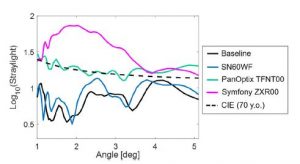Purpose: To show the importance of measuring the angular distribution of straylight as an in vitro test for intraocular lenses (IOLs).
Methods: The optical integration method was implemented to measure the point spread function, up to 5.1°, of IOLs immersed in a wet cell. The straylight parameter was calculated as the product of the point spread function by the squared angle. The effect of the scattered light is shown in extended images of a target surrounded by headlamps as glare sources. Three different IOLs were tested: (1) AcrySof IQ SN60WF, monofocal, (2) AcrySof IQ PanOptix, trifocal, and (3) Tecnis Symfony ZRX00, bifocal with extended depth of focus. Measurements were compared to previously reported clinical studies where the same IOL models were implanted.
Results: Themean amount of scattered light, between 1.0° and 5.1°, generated by each IOLs were, in deg2sr–1 units: (1) 1.2, (2) 12.1, and (3) 33.4. Lens (3) present a high amount of straylight related to a halo of an approximate diameter of 2°.
Conclusions: In vitro measurements of the angular distribution of the point spread function of different types of IOLs showed important aspects related to their manufacturing quality. These results are in line with previous clinical findings where glare sensitivity was tested in the same angular range.
Translational Relevance: In vitro measurement of angular dependence of straylight in IOLs, regardless their design, provides a valuable feedback to improve their optical quality. The minimization of the amounts of straylight positively impacts the recurrence of photic phenomena.


